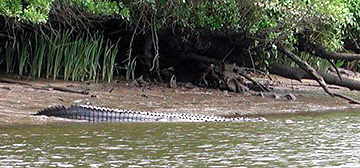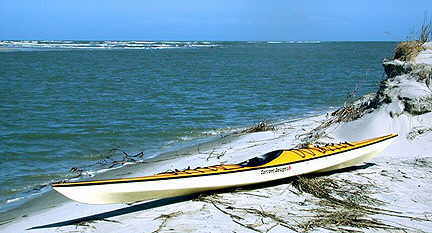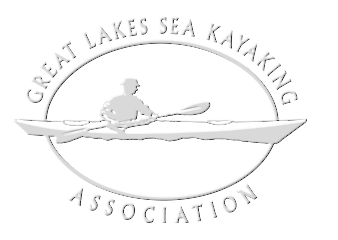
by Keith Rodgers
We have driven down the monotonous stretch of the I-95 south of Richmond, Virginia. Miles of straight blacktop, except when it’s silver grey concrete streaked with long black rubber skid marks that end with no explanation, not even a shard of glass. It was late in April when we came south, and by mid-morning it was already hot on the Carolina coastal plain. Large billboards pushing fireworks and towel outlets flicked by. The carcasses of dead truck tires lay in twists on the highway’s shoulder, mile after mile. Like the rest of the endless traffic we ran along at a respectable 10 mph above the limit. From time to time I checked breaks in the roadside tree cover for the cars of lurking state troopers or glanced up through the windshield at the rope securing the prow of the kayak on the car roof. For over 800 miles neither gave us any trouble.
As predictable as the movement of a caribou herd or a flock of geese, the annual spring migration of Canadians sends a flood of Ontario and Quebec license plates southward down the interstates, most of them turning off for the sand and motel strips of Nag’s Head or Myrtle Beach. But for us it’s mid afternoon of the second day of driving before we turn east onto the I-26, towards the Charleston peninsula, the clean Atlantic and the chain of barrier islands that stretch southwards through Georgia.
I have been visiting this part of the world for almost twenty years now. For the first few years I hauled my canoe along, but the almost constant south-westerly wind blowing up the estuaries and the swells and surf of the ocean saw the canoe sitting neglected on the shore most of the time. My discovery of sea kayaking changed all that. Now I come down to meet friends and polish skills for three days at the East Coast Canoe and Kayak Symposium in Charleston. The Symposium is now over and it’s a family vacation with day trips through the creeks and marshland which line the coast or a paddle through a tidal inlet lined with dunes out into the warm surf breaking on the sand bars at the inlet’s mouth. By the third week in April the water temperature in Charleston harbour has reached almost seventy degrees, and it will continue to climb steadily to its summer maximum in the mid eighties.
On this particular hot morning we have come a few miles inland, to paddle on the Edisto, one of the larger of the many black-water rivers that come out of the mountains of West Virginia and North Carolina to meander across the coastal plain to the sea. We pull into a small park at the West Bank public boat landing near Parker’s Ferry. The ferry was replaced years ago by the predecessor of the bridge that today carries Highway 17 on its way south from Charleston to Savannah. The parking area is in deep shade, overhung with huge live oaks, their branches strung with silvery-grey Spanish moss. We are about 8 miles north of the thick blue line on my map showing the change of the river water from salt to fresh. Although it is based on the mean high tide it’s pretty much an arbitrary line, as the transition zone itself is always shifting, moving up and down the river as the tides flood in and out, always pushing against the outward stream of the cold fresh water coming from the hills. Here at Parker’s Ferry the tea-coloured river is about 150 yards wide with a slow current, but it’s still tidal. I taste the water, expecting to find it brackish, but it’s sweet. What’s happening is that the fresh water is flowing slowly over the top of the incoming tidal flood of seawater. This tendency of the river water to float in a layer on top of the denser salt water means the incoming tide hoists up millions of gallons of fresh water twice a day. Build dikes and sluices along the muddy banks, open and shut the sluice gates at just the right times and in the fields behind the dikes water-loving crops can flourish. In the 17th and 18th centuries just such an engineering feat was accomplished by the terrible labours of the slaves. In the waterlogged fields they planted indigo, an unremarkable looking plant that when harvested and fermented in vats yielded a marvellous violet-blue dye. But when garishly coloured chemical dyes came along early in Victoria’s reign, fashionable women in England and America abandoned the softer vegetable hues. So the planters switched to rice, and flourished until the twin disasters of the Civil War and the growth of Asian competition finished them off.
Today almost nothing remains of the sluices and earthworks along the Edisto, but along the Ashley and Cooper rivers, just upstream from Charleston, visitors to the few surviving splendid plantation houses can look at the embanked rice fields and restored sluices and wonder at the ingenuity, and back-breaking work, that made the city one of the largest and wealthiest in eighteenth-century America.
Well before the planters came, other riverbank dwellers had welcomed the reluctance of the fresh water to blend with the salty tide, . The alligator, unlike the crocodile, avoids salt water, and by carefully swimming in the freshwater layer is able to extend his range downstream. Someone had told us that they were plentiful for a few miles south of Parker’s Ferry, and, in the same helpful spirit, had pointed out that the warm spring weather would encourage their boisterous mating behaviour.
It’s low tide but on the turn as we put two kayaks into the river and paddle out of the shade into hot, hazy sunlight and across to the far side. An osprey flies overhead and a bald eagle sits in a tall but dead cypress, looking as if it were posing for a coin. This would be an impressive start for a bird watcher, but my paddling companion, my 23 year-old daughter, has alligators on her mind and she is excited and scared in about equal measure. Almost immediately we come across a four-foot long specimen lying on the exposed muddy bank. At this size he is a cousin to the animals we have been seeing most days lurking around the water hazards on the golf courses on Kiawah Island, where we are staying and so is no cause for alarm. As I reach for the catch on the camera case strapped ahead of the cockpit I notice, about twenty feet ahead of us on the bank, a much, much bigger alligator rising up on his forelegs, a large pouch of skin hanging at his chest, and his mouth partly open. Later Emma will describe him as being as long as her kayak; I estimate twelve feet, short for a kayak but still very impressive for an alligator when you meet him on his own territory. I remind myself that his mouth is open for ventilation, and that he is heading our way because we are in the water, which is where he also wants to be. I ask Emma to paddle ahead so I can get her in the picture and so give a sense of scale; she disappoints me by simply looking at me in astonishment. The click of my camera case sends the alligator slithering on his belly into the water, and my shot catches a long tail on the bank and a head and snout about six feet out in the river; he slips in fully and sinks out of sight without a sound or a bubble. We see three more alligators on the bank, all modest in size, before we turn into a narrow creek that winds through a dense jungle of reeds and broad-leaved plants with saucer-sized white flowers armed with pointy-tipped spikes that look designed to catch small birds.

The incoming tide moves us rapidly upstream in about ten inches of water. The sand and mud banks extend five feet above our heads; across them hundreds of scurrying fiddler crabs scramble into their holes as we glide past. In the trench of the creek the heat presses down on us. Suddenly we hear sustained loud crashing noises in the dense reed cover to our right. Whatever it is, it’s large and completely unconcerned about giving its presence away. We can’t see it, but expect that at any moment something will burst into sight above us on the bank; this is more alarming than the big alligator. We manoeuvre around a corner and come to a stop. A large log lies across the creek bottom, on the far side of which a small green aluminum punt has come to rest. An elderly man sits on the seat, flicking a fishing line ahead of him,
“Hogs,” he says “wild hogs. Got across this log coupla hours ago but now I gotta wait for a little more tide before I kin git back.” We chat about the fishing. He was hoping for red spot, a local variety of bass, but has seen only catfish, which he holds in contempt. I mention the alligators, “Won’t hurt you if you leaves ’em alone,” he says and turns back to his fishing. We turn around with some difficulty and paddle back into the main current. Already the mud banks have vanished beneath the tide, and the alligators with them. On the far side of the river is a pretty cabin, covered with cedar clapboard. Down at the water’s edge the owner has built a small dock with a children’s slide at one end: presumably he shares the old fisherman’s view that the local alligators are no threat.
The river current is still slipping over the top of the incoming tide as we paddle with it downstream. On the riverbanks we see elegant Louisiana herons, thin as runway models. So as not to startle them we move out into the middle of the wide river. On shore the cedars and cypresses are thinning as the Edisto flows through the Snuggedy swamp, which is not as cozy as its name. Prairies of bright green spartina grass start to appear, dotted with hammocks of dry land covered with tall loblolly pines and edged with fringes of bayberry bushes. We are now in the ACE Basin nature reserve.
The reserve takes its name from the Ashepoo, Combahee and Edisto rivers, whose mouths and wetlands it encompasses. Covering 350,000 acres, it’s home to 265 species of birds, including the wood stork (no sign of them today), and white ibis, clapper rails and brown pelicans; we see lots of these, and a few more whose names escape me. Set up in 1990, the ACE basin might have been designed with sea kayakers in mind; it wasn’t, but it’s hard to imagine a better way of seeing this vast area of salt marsh, tidal inlets and miles of almost-deserted beaches. We turn up into another side creek. The water flooding in is now about five feet deep and rising rapidly up the brown muddy banks. We manoeuvre around a bend and the bank turns to clean sand as the creek cuts alongside a hammock of dry land covered with a thick entanglement of sea myrtle and bayberry, out of which stick some slash pines and a palmetto. The creek narrows down so that our paddle blades are almost brushing the banks on either side. We back out until we reach the mouth of a smaller tributary, which we had failed to notice as we came in. It allows us to turn around. It’s easy to get lost in a big salt marsh, and it can be a messy business scrambling up to the top of a bank, sinking into the mud as you try to catch sight or sound of the sea, which in this marsh will tell you which way is west. Today, I have a compass fastened on the boat.
The sides and bottoms of these channels are everywhere made of the rich, glutinous mud, which Carolinians call pluff. Get the tide wrong and you may be forced to wade in it, dragging your kayak behind you. You’ll find the top few inches are the colour and texture of dark chocolate pudding. A little further down and the texture thickens to cheesecake; at about a foot it turns to toffee and stays that way for another two feet or so until you hit bottom. Stretchy mesh nylon beach shoes or river sandals with worn Velcro fasteners are easily claimed by the mud as you haul your feet up against the suction. If you are not squeamish, bare feet are fine – the mud is full of life but nothing alive in it is likely to hurt you. The dead stuff is another matter – old oyster shells, spiky cordgrass stems and splintered whelk shells can scratch, cut or even prompt brief irrational thoughts of large, bad-tempered crabs. My solution is to go carefully barefoot or wear cheap, laced canvas shoes, the kind you can throw in a washing machine.
The temperature feels in the high 80s, unseasonably warm as we follow the west bank down to the totally deserted public landing at Willstown Bluffs. We’ve come about five miles southwest of the I-17 and are not far from the sea. Here the riverbank is a small sand beach edged by a low bluff, cut through by a sunken dirt road were the car is waiting. Our bows nudge softly into the sand, we climb out and splash in the warm water. The river is now entirely salt and we hear the sound of surf in the distance.

With the kayaks strapped on, we drive back towards the highway. Spring growth has almost covered the beer cans, torn plastic bags and decaying cardboard cartons that still festoon the sides of many roads throughout the South. The problem is bad in South Carolina, but rises to a crescendo of mindlessness in Georgia where even the yaupon holly and greenbriar bushes that edge the beaches on the National Wildlife Refuges rise out of a mulch of bags and cans. You learn to ignore it; which of course is part of the problem. Today, there are quail scurrying in the grass and we see a small group of deer standing in the shade of some live oaks at the edge of a field that’s covered with a green fuzz of some crop I don’t recognize. The live oaks are draped with Spanish moss, just like in the pictures. We turn onto the highway and join the stream of traffic slipping along to Charleston at a reasonable pace above the legal limit.
RESOURCES:
Map:
Coastal Expeditions publishes an excellent, large-scale map of South Carolina showing public boat landings and canoe and kayak put-ins. Contact Coastal Expeditions, P.O. Box 556, Sullivan’s Island S.C. 29482 U.S.A. or www.coastalexpeditions.com.
Books:
Sea Kayaking the Carolinas, James Bannon & Morrison Giffen, Asheville, NC: Out There Press
Tideland Treasure, Todd Ballantyne, Hilton Head, SC: Deerfield Publishing
